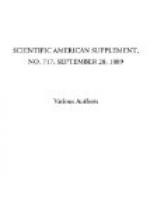The alkali act forbids the manufacturer to allow the escape of more than 5 per cent. of the hydrochloric acid which he produces, or that that acid must not exist to a greater extent than 0.2 grain in 1 cubic foot of air, steam, or chimney gas which accompanies. The inspectors’ figures for last year show that the percentage of the acid which escaped amounted to only 1.96 of the total produced, which is equal to 0.089 grain per cubic foot, and much below the figures for previous years. The figures in regard to sulphurous gas are equally satisfactory. The act allows 4 grains of sulphuric anhydride (SO3) per cubic foot to escape into the air, and last year’s average was only 0.737 grain, or less than a fifth of the limit.
Of course it is now the aim of the Leblanc alkali manufacturers to reduce the escape of hydrochloric acid to the lowest possible amount, as their profits depend solely upon the sale of chlorine products, soda products being sold at a loss. In this connection it is interesting to note that the amount of common salt manufactured in the United Kingdom in 1888 was 2,039,867 tons, and of this nearly 600,000 tons were taken by Leblanc soda makers, and over 200,000 tons by the ammonia-soda makers. The figures are very largely in excess of previous years, and indicate a gratifying growth in trade.
The salt used in the Leblanc process yields the hydrochloric acid, and that in the ammonia-soda method none, so that we may put down the theoretical production of acid as 380,000 tons, 7,600 tons of which was allowed to escape.
What was a mere trace in the chimney gases amounts, therefore, to a good round figure at the end of a year, and if it were converted into bleaching powder it would be worth nearly 150,000l. These figures are, it should be understood, based on theory, but they serve to show to what importance a gas has now reached which twenty-five years ago was a perfect incubus to the manufacturers, and wrought desolation in the country sides miles and miles around the producing works. There has long been an expectation that the ammonia-soda makers would add the manufacture of bleaching powder to their process, but they appear to be as far as ever from that result, and meanwhile the Leblanc makers are honestly striving to utilize every atom of the valuable material which they handle. Hence the eagerness to recover the sulphur from tank waste by one or other of the few workable processes which have been proposed.
This waste contains from 11 to 15 per cent. of sulphur, and when it is stated that the total amount of tank waste produced yearly is about 750,000 tons, containing about 100,000 tons of sulphur, it will be seen how large is the reward held out to the successful manipulator. Moreover, the value of the sulphur that might possibly be saved is not the only prize held out to those who can successfully deal with the waste, for this material is not only thrown away as useless, but much expense is incurred in the throwing.




